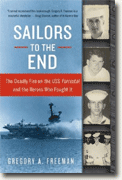Gregory A. Freeman
book reviews:
· general fiction
· chick lit/romance
· sci-fi/fantasy
· graphic novels
· nonfiction
· audio books
· author interviews
· children's books @
curledupkids.com
· DVD reviews @
curledupdvd.com
newsletter
win books
buy online
links
home
for authors
& publishers
for reviewers

 |
Sailors to the End: The Deadly Fire on the USS Forrestal and the Heroes Who Fought It Gregory A. Freeman Avon Paperback 451 pages June 2004 |
"They were sailors to the end. They never begged for mercy. They never whined. They never whimpered." - Commander Merv Rowland, chief engineering officer, USS Forrestal.Nearly every man-made disaster is due to a series of mundane events, which if any one of them were interrupted, would result in a totally different outcome. Such was the case of the deadliest warship incident since World War II. On July 29, 1967, the USS Forrestal was on Yankee Station in the Tonkin Gulf off of the coast of South Viet Nam. The Forrestal was an aircraft carrier and had been on station for four days. As a modern carrier she was a huge ship, the first carrier designed so that jet planes could launch and land simultaneously. She was so large that those who have never seen a modern carrier would have difficulty comprehending her immensity. She had a crew of about five thousand and carried about ninety planes. Her flight deck was approximately four acres; the flight deck is considered to be the most dangerous location of any work station in the Navy. It was on the flight deck that this terrible tragedy commenced.
One of the most poignant incidents inspired the quote at the beginning of this review. All modern warships have emergency manual steering in the aft portion of the ship below deck. They are always manned in case control from the bridge is lost. The Forrestal had two rudders, aport and astarboard , with two corresponding emergency steering compartments. The exploding ordinance blasted through the decks and severely injured and trapped three men in the port emergency steering compartment. They knew they were dying, and the chief engineering officer, Commander Merv Rowland, knew they were dying. Commander Rowland also knew that if they lost steering, the imperiled ship’s position was even more untenable. He ordered the dying men to manually transfer the port emergency steering to the starboard emergency steering. This was their last act. The author assigns much of the responsibility for this tragedy to then Secretary of Defense Robert McNamara and President Johnson. McNamara demanded more bombing missions than available stockpiles would warrant. As a result, the Navy had to augment their ordinance with very unstable WWII bombs. Modern bombs don't cook off in fire; old bombs do. The old ones are the ones that exploded. Also, McNamara put unreasonable expectations on the flight schedules, leading plane crews to take shortcuts on loading ordinance in the interest of saving time. Planes had a limited amount of fuel to stay in the air, and they all had to be launched in a very short time period to fly as a group and have enough fuel to return. The author also absolves the captain, John Beling. As a previous Navy man from the same period, I do not agree with the author on this one point. When I was in the Navy, the captain was responsible for everything that happened aboard ship regardless of circumstance. Having said that, I do think this is a well-researched and well-written book. It makes a very good read. © 2004 by Donald Allan Scott for curledup.com. |
| Also by Gregory A. Freeman: |
|
|
|
 Click here to learn more about this month's sponsor! |
|
| fiction · sf/f · comic books · nonfiction · audio newsletter · free book contest · buy books online review index · links · · authors & publishers reviewers |
|
| site by ELBO Computing Resources, Inc. | |
 On that morning, the Forrestal was launching air strikes against targets in North Viet Nam. As planes were being staged for launch, a Zuni rocket from one of the planes misfired and struck another plane, rupturing the fuel tank and starting a fire on the aft portion of the flight deck. Incidental to the event, the struck plane was that of John McCain, who was strapped in the pilot's seat waiting to take off. The burning liquid spread quickly and started cooking off ordinance stored on deck. The entire crew of firefighting specialists was lost to exploding ordinance, leaving those less trained in firefighting to react. To save the ship, the planes and ordinance had to be jettisoned, most of it manually - all the while the crew passing through raging fires and explosions. The fire burned through the flight deck and spread to other portions of the ship. As the burning liquid spread, hazardous gases filled many compartments of the ship.
On that morning, the Forrestal was launching air strikes against targets in North Viet Nam. As planes were being staged for launch, a Zuni rocket from one of the planes misfired and struck another plane, rupturing the fuel tank and starting a fire on the aft portion of the flight deck. Incidental to the event, the struck plane was that of John McCain, who was strapped in the pilot's seat waiting to take off. The burning liquid spread quickly and started cooking off ordinance stored on deck. The entire crew of firefighting specialists was lost to exploding ordinance, leaving those less trained in firefighting to react. To save the ship, the planes and ordinance had to be jettisoned, most of it manually - all the while the crew passing through raging fires and explosions. The fire burned through the flight deck and spread to other portions of the ship. As the burning liquid spread, hazardous gases filled many compartments of the ship.